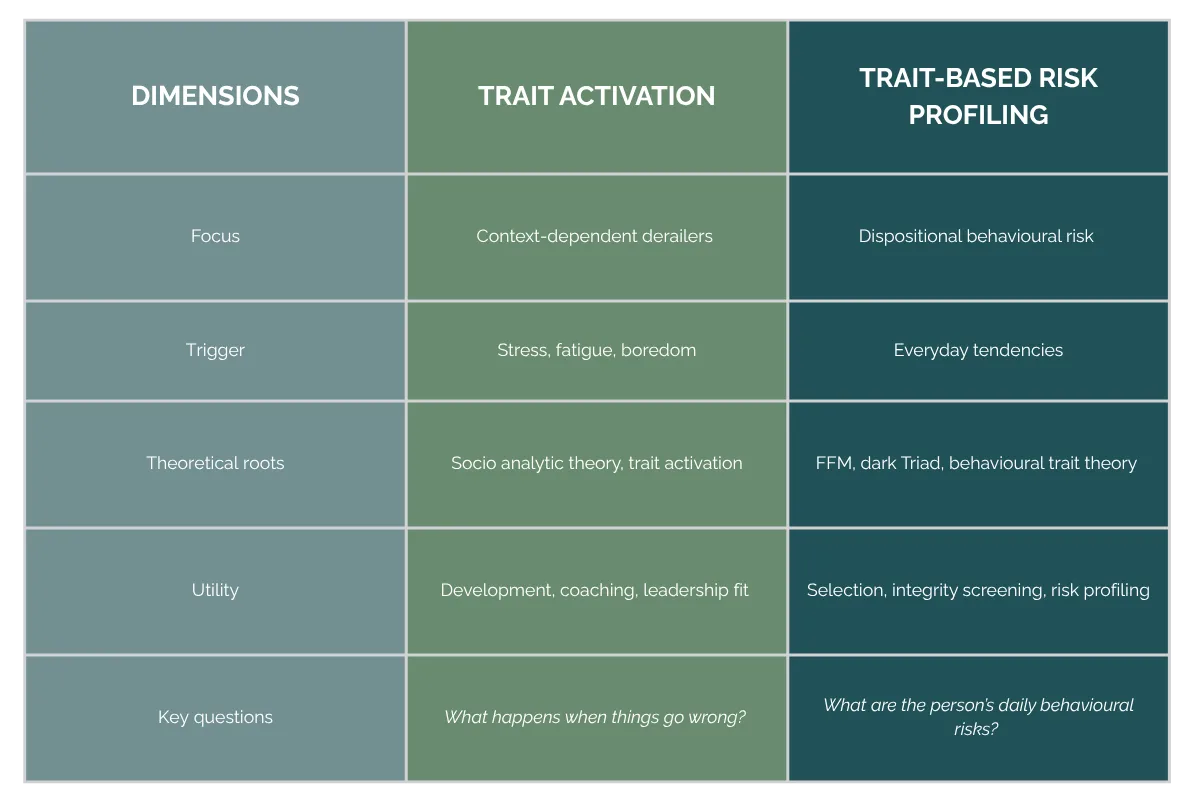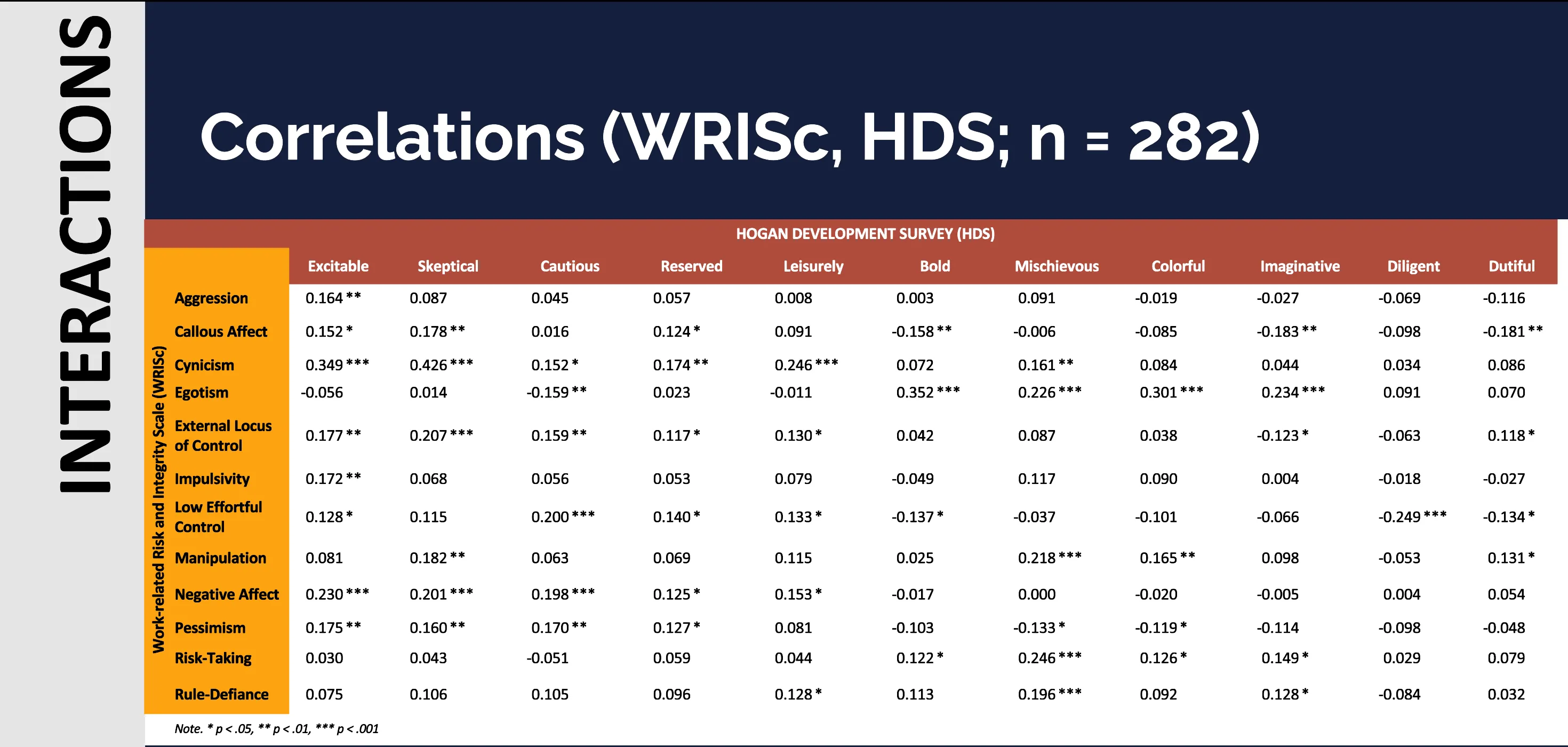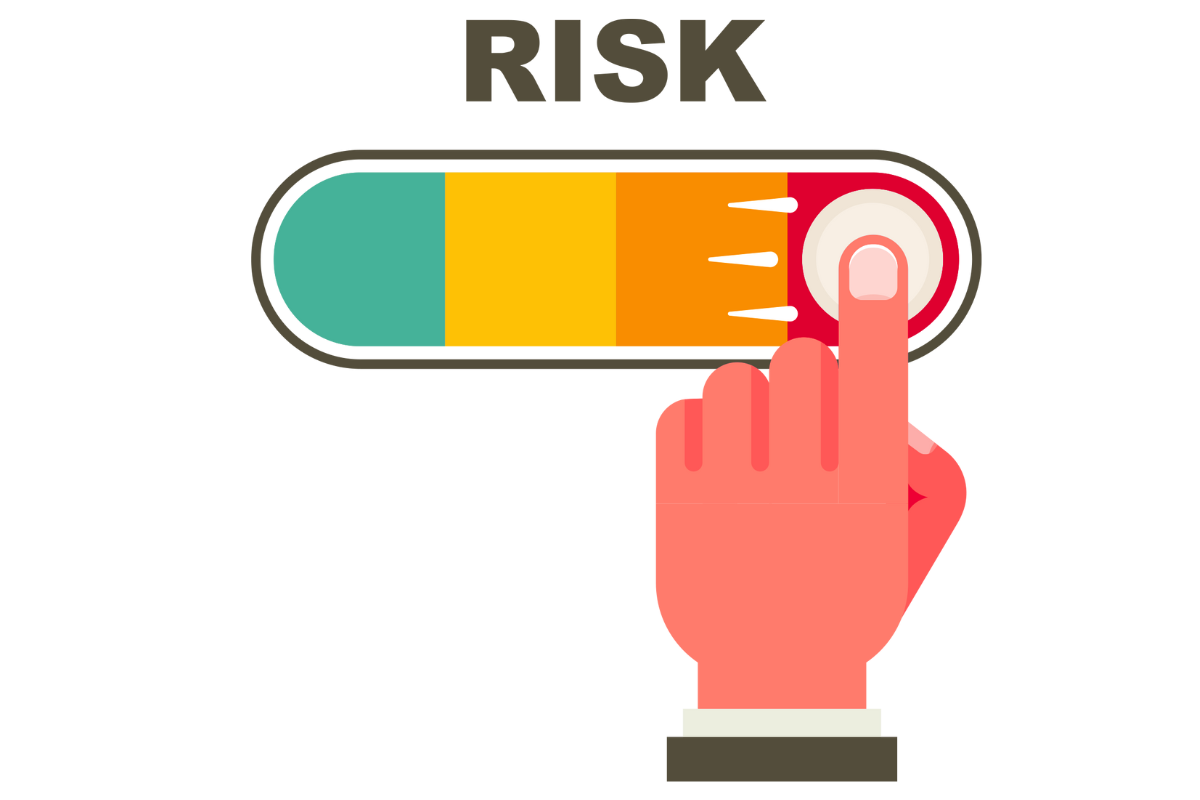In the world of work, we often assess personality to predict performance, ensure culture fit, or guide development. But increasingly, organisations are turning to personality data to answer more difficult questions:
Who might bend the rules under pressure?
What behaviours undermine trust and team dynamics?
How can we spot integrity risks before they escalate?
When it comes to assessing behavioural risk in the workplace, psychologists and practitioners have long relied on personality assessments to spot the warning signs of counterproductive work behaviours (CWBs). While the Big Five traits like conscientiousness and agreeableness give us helpful clues, they may at times fall short of capturing the full spectrum of behaviours that concern HR, compliance, or leadership teams. That’s where dark-side personality theory steps in, and where different assessment models offer distinct and sometimes complementary, perspectives.
Bright vs. Dark: A Continuum or a Category?
At the heart of this conversation is a foundational question in personality psychology:
Are “dark” traits just the extreme ends of “bright” traits, or are they categorically different?
Some researchers argue for a continuum view. In this model, risk-related behaviours can be inferred by looking at the low (or high) ends of normal traits:
Low agreeableness may translate to cynicism or coldness.
Low conscientiousness may show up as irresponsibility or impulsiveness.
High neuroticism may manifest as emotional volatility or low stress tolerance.
These patterns align with many trait-based risk profiling tools, which map personality risks directly onto known dimensions of behaviour. For instance, a combination of high impulsivity and low effortful control could indicate a potential for risk-taking or poor self-regulation, which are both relevant to workplace integrity concerns. However, this model assumes a fairly linear relationship between traits and behaviour. Low conscientiousness may suggest carelessness but doesn’t necessarily point to rule defiance. High extraversion may suggest energy, but not manipulativeness.
In contrast, the category view suggests that dark traits like narcissism, psychopathy, and Machiavellianism are not merely extremes, but qualitatively different configurations of behaviour. These traits may include callousness, manipulativeness, or grandiosity, which are features not as easily captured by the Big Five framework.
This perspective often underpins models of personality derailers, where darker tendencies lie latent until triggered by stress, fatigue, or threat. Here, a confident leader may tip into arrogance under pressure, or a detail-oriented manager may become overly rigid when overwhelmed. These traits are not visible day-to-day but rather activated by context. By zooming in on maladaptive variants of normal traits, or by mapping patterns of antisocial behaviour more directly, we can better address the question of assessing personality-based risk.
Two Pathways to Assessing Personality Risk
From these two perspectives arise two dominant models of workplace risk assessment. While both approaches offer insight, they ask different questions; Trait-Based Risk Profiling focuses on who the person is, while Trait Activation/Derailment models consider how the person may change under specific circumstances.
Trait-Based Risk Profiling
This approach assumes that integrity risks are generally dispositional, regardless of external conditions. The traits associated with risk, such as Pessimism, Impulsivity, or Manipulation, are consistently expressed across time and contexts. These day-to-day behavioural tendencies assessments often blend the Five-Factor Model with constructs from the Dark Triad to detect potential for CWB’s.
Examples of links to everyday personality indicators:
- Impulsivity and low effortful control (linked to low conscientiousness)
- Callous affect and manipulativeness (low agreeableness)
Recommended use: Selection, succession screening, ethics audits
Strength: Useful for identifying individuals whose typical behaviour may challenge collaboration, rule compliance, or psychological safety.
Trait Activation and Derailment Models
This model is grounded in the idea that everyone has dark-side potential, but triggers such as stress, boredom, or pressure uncover these latent vulnerabilities. Traits like Excitable, Sceptical, or Bold may be assets in moderation, but become derailers when overused or contextually misaligned.
Examples of strengths that may derail when triggered by context:
- A Cautious individual might become indecisive when faced with ambiguity.
- A Bold thinker might take unnecessary risks when bored or unchallenged.
Recommended use: Leadership development, coaching, high-stakes team dynamics
Strength: Helps understand how someone may react under strain, not just how they typically behave.
Table 1: Summary of trait-based and trait activation measures

Complementary, Not Competing
JVR Psychometrics are often asked whether we recommend the Work-related Risk and Integrity Scale (WRISc), based on the trait-based risk profile model, or the Hogan Development Survey (HDS), based on the trait activation and derailment model, to assess risk. However, this is a difficult question to answer given that the assessments have different purposes, and in fact, the two models work best when used together. A trait-based profiler might flag someone with a pattern of manipulative and callous behaviours, even if they’re currently calm and collected. A trait activation model might flag the same individual’s potential to derail under pressure, revealing a different side that emerges only in certain environments.
When used side by side, these approaches allow practitioners to:
Triangulate risk: Confirm patterns across tools and reduce false positives. By offering a 360° view of both chronic tendencies and triggered derailments, for example, a candidate who flags on the WRISc narcissism index but has mild HDS scores, may quietly erode team cohesion long before any dramatic blow-up occurs.
Contextualise behaviour: Understand if a risk is always present or only under specific conditions.
Design tailored interventions: Use development coaching for situational derailers, and behaviour-focused feedback for consistent traits.
This also supports more ethical use of assessments. Risk doesn't automatically equate to untrustworthiness or failure. Many “risky” traits, like boldness or rule-defiance can drive innovation in the right roles. But understanding the why, when, and how behind these traits is essential for fair and informed decision-making.
This difference is reflected in WRISc and HDS data too. A recent study examined how WRISc scores correlate with the HDS derailers in a sample of 282 South Africans. The results indicate mostly low-to-moderate correlations, which are more indicative of discriminant, rather than convergent validity. In other words, the two tools are measuring related, but distinct constructs. Egotism may relate to Bold, and Rule-Defiance to Mischievous, but these aren’t one-to-one mappings. The overlap is partial and situational.
Table 2: WRISc and HDS correlation matrix

Rethinking Integrity in Organisations
When we talk about “integrity” at work, we often think of honesty, ethics, or reliability. However, when considering the WRISc and HDS alongside most integrity reports, the assessment is actually used not to predict integrity, but rather behaviours considered to reflect an absence thereof and a higher likelihood to engage in counterproductive behaviour. Integrity is also about consistency of behaviour, how reliably someone aligns their values, emotions, and actions across different contexts.
This means that integrity assessments should consider both:
- The likelihood of certain behaviours (trait-based risk)
- The conditions under which values might be compromised (trait activation)
In a volatile, uncertain, and high-pressure work environment, it’s not just who someone is, but who they become under stress that shapes ethical climates and team dynamics. Recognising this duality helps organisations move beyond surface-level character judgments and toward a more scientific understanding of behavioural risk.
Conclusion: More Than One Lens
Ultimately, risk and integrity at work is not simply about labelling people as “bad apples”. It’s about understanding behaviour in context, identifying red flags early, and promoting development and ethical alignment. Whether we’re assessing stable tendencies (WRISc) or stress-triggered derailers (HDS), both tools help paint a richer, more nuanced picture of the human dynamics shaping workplace performance. Whether you’re selecting new hires, developing leaders, or strengthening ethical culture, the question isn’t which personality model is “best”. It’s which combination of lenses helps you see more clearly.
In a world where misconduct often hides in plain sight, organisations benefit most from layered insights and proactive prevention. Used wisely, tools like the WRISc and HDS can help practitioners not just decode workplace risk but meaningfully manage it.
Share this post
Newsletter
Get up-to-date industry news right in your inbox



